

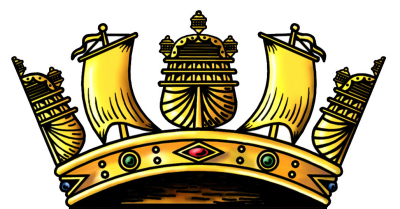
The Naval Crown
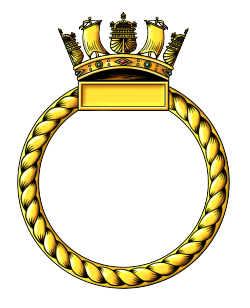
Circular
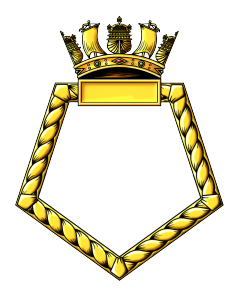
Pentangle
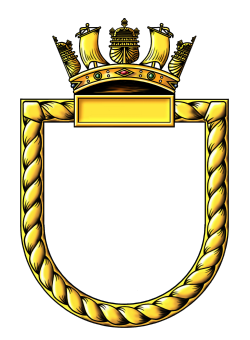
Sheild
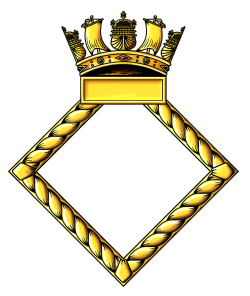
Diamond
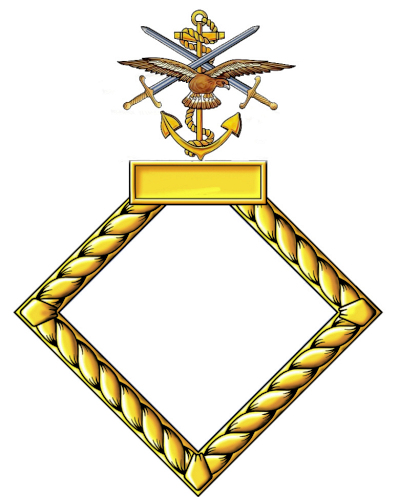
Joint Services Centres
Often incorrectly referred to as Crests – ‘Waves have crests, Ships have badges’
Prior to 1919 unofficial badges were in common use in RN vessels, not all of them were appropriate or tasteful. The Admiralty had planned to implement a set of rules to standardise badges but this was shelved at the outbreak of the First World War. examples
The idea was revisited in 1918 when the work of Charles ffoulkes came to the Admiralty. Ffoulkes, an expert on firearms and mediaeval armour at The Tower of London, served as a sub-lieutenant in the Royal Naval Volunteer Reserve at the start of World War One before being appointed as Curator of the new National War Museum (now the Imperial War Museum) founded on March 5th 1917.
When the 'R' class destroyer HMS TOWER was launched on April 5th 1917 at the Swan Hunter Wigham Richardson shipyard on the Tees her Commanding Officer asked George Richardson, a director of the company for a suitable badge for his ship. Richardson, enlisted his friend Charles ffoulkes a fellow collector of ship’s badges. The result was a design showing the White Tower of the Tower of London above which is inscribed "HMS TOWER". The frame was in the form of a garter belt on which is inscribed "GOD SAVE KING GEORGE AND HIS TOWER". Above the frame is the royal crest of England. Following this ffoulkes was invited to design for other shipyards; by the end of the war in 1918, ffoulkes had designed and produced over twenty badges.
He was approached by the Deputy Admiralty Librarian, Leonard G Carr Laughton who asked ffoulkes whether he would consider preparing designs for the whole fleet. ffoulkes agreed but required two of each design to be cast in brass - one for himself and one for the Imperial War Museum. On December 5th 1918 a new ‘Ships Names and Mottoes Committee’ met formally for the first time, it was chaired by the Director of Naval Equipment (DNE). Charles ffoulkes was appointed Admiralty Adviser on Heraldry on December 18th 1918.
ffoulkes set out the following criteria for the proposed designs:
1. The design should illustrate the name of the ship.
2. The historical associations of the ship should be considered.
3. The design should be simple, striking and easy to paint.
4 . The motto, where given, should be appealing.
5. Offers of designs from ships would be carefully considered.
Battle Honours would be a separate issue but it was agreed that a Battle Honours Board would incorporate the badge (and motto, if granted) for display in a prominent position on board.
Badges already in use would continue to be displayed, but new ships would carry only sealed Pattern designs which could not be altered without the Committee's permission. Commanding officer of ships were to send in details of their existing badges, with comments, for submission to the committee. The first official design was produced on February 19th 1919. 223 were completed in the first year.
Four designs were decided up - Circular, Pentagonal, Shield and Diamond, which were allocated to four groups of vessel types:
Circular –Battleships & Battle Cruisers
Pentagonal – Cruisers
Shield – Destroyers
Diamond – All other vessel types and shore establishments
The Naval Crown, the badge of the Royal Navy, was added to the top of the four badge shapes to form the designs we know today; this however shows the only shows the front elevation of the full design.
The Naval Crown consists of a circlet surmounted by four sterns of men o'war each with three poop lanterns and four square sails spread on a mast and yard fully fitted and sheeted home, the ships and sails being positioned alternately. The colours of the jewels on the Naval Crown have remained unchanged, the centre stone is a ruby (red), flanked by two emeralds (green) and flanked in turn by two sapphires (blue) on either edge. Between each stone is a pair of white pearls. The full Naval Crown forms the finial of the Jackstaff on the bow of a ship from which the Union Jack is flown; a Royal Crown forms the finial of the ensign staff at the stern from which the White ensign is flown.
The name board of these badge shapes was to be colour coded as follows:
Capital ships: gold letters on a blue field
example
Cruisers: gold letters on a poppy red field example
Destroyers: gold letters on a black field example
Aircraft carriers: gold letters on a light blue field - not used
example
Sloops, submarines, depot ships, etc: gold letters on a green field
example
This convention seems to changed almost as soon as it was introduced: the light blue name plate field was applied to some depot ships. example
The system was revised after 1939 and in 1940 it was decided to give new warships (if entitled) a round frame. Escort carriers bearing ship’s names that had not been in use before received circular badges, as did Fleet Air Arm squadrons. Those with a re-used name inherited the design but were transferred into the circular (now known as the standard) design shape example . This colour code was also dropped, the standard design became gold letters on a black field. This was subsequently changed to black letters on a gold field, thereby allowing the whole frame and crown to be gold.
Shore Establishments would now take the diamond shape and the Royal Fleet Auxiliary Service was now granted badges in the old cruiser shape, a pentagon. Existing ships would keep existing shapes and designs; on the name being reissued the badge should have been transferred to the appropriate shape, but his was not always done. In 1991, Defence Council Instruction (DCI) 40/91 noted that some ships were still using the shapes allocated in 1919 and the practice was to cease.
All designs, were painted by the College of Arms, approved by the Ships Names and Mottoes Committee and sent for carving. All designs for Capital Ships were, and continue to be. submitted for approval by the Sovereign, but signed by the Chairman or designated signatory. This was the Sealed Pattern. The next stage from artwork was carving. This was done in yellow pine by Messrs Martyns of Cheltenham. The sample carvings then sent to the Royal Dockyard at Chatham where castings were duly made and sent to the Committee for approval.
The first ship of the Royal Navy to bear an official badge was
HMS Warwick the Sealed Pattern being approved on
May 5th 1919. Following the post-war depression which saw many workers laid-off, it took until June 1921 to produce the two first castings in brass - TIGER and WISHART. A set of brass badges for a battleship would consist of a screen badge on the bridge, a set of five inches and seven-inch boat badges (two for each of 16 boats), gun tompions for up to 20-gun barrels and Battle Honours Boards, etc. displaying one apiece.
When ffoulkes retired in 1936 to take up the post of Master of the Tower Armouries, he had researched and designed over 550 badges. He was succeeded by Sir Arthur Cochrane, Clarenceux King of Arms at the College of Arms. In addition to designing ships badges he produced the designs for the first Fleet Air Arm badges in 1936 in conjunction with Chester Herald John Heaton-Armstrong who was the Adviser to the Royal Air Force. 930 designs were approved during Sir Arthur's time. The large expansion of the Royal Navy during 1939 -45 resulted in a huge backlog of applications for a ship’s badge; with the rapid scaling back of the fleet post-war and the reduction in new builds orders the backlog was tackled.
Sir Arthur Cochrane died in 1954 and was succeeded by Somerset Herald, Michael Trappes-Lomax, until his own retirement in 1966; he produced over 100 designs including several for Royal Fleet Auxiliaries and new Naval Air Squadrons. The next Adviser was a retired naval officer, Captain Barraclough RN who had served on DNE's staff in 1936. He filled the post for five years and turned out over 30 designs. In 1972 the post was filed by Sir Walter Verco, Norroy and Ulster King of Arms who submitted over 70 designs before he left the post in 1996. The next heraldic advisor was Thomas Woodcock, Norroy and Ulster King of Arms (later Garter Principal King of Arms from 2010).
Some ship's names were never granted a badge - this could be for several reasons; the most common is the ship was lost before a design was approved, If a war-time ;lend-lease’ vessel the ship was returned to US custody before a design was approved (some designs were not approved until mid-1945 and if a design was not finalised before the war ended it may have been abandoned).
In some cases, a vessel was overlooked; the World War One destroyer VANOC, is a good example, she was in the Reserve Fleet when the other ships of her class were badged. She continued in service for 25 years until being scrapped in 1945 having never received a badge.
Longevity is no guarantee being granted a badge either; HMS MALABAR, one of Britain's oldest naval bases, dating from the 18th century, in Bermuda had a design rejected in 1922 followed by a second rejection in 1949, the base used an unofficial badge in lieu. a Sealed Pattern was finally produced in 1992- the base was closed three years later. Another example is HMS SIMBANG m Royal Naval Air Station Sembawang in Singapore, the base was commissioned on three occasions 1945 -47, 1950-62 and 1962-71 but never received an approved badge; an unofficial badge was created showing a Lesser Frigate bird in flight which is in Malaysian is a Simbang Kecil.
In many cases the design submitted to the ‘Ships Names and Mottoes Committee’ had already been locally cast in metal and was proudly displayed on board; many of these designs were rejected and so remained in use as unofficial badges. This was more common during the Second World War as the sheer volume of designs being summated resulted in severe delays in a pattern being approved for designs which were accepted.
Often the unofficial badge was in the wrong shape and upon applying to be badged were replaced by completely different official designs - the escort carriers again provide good examples;
ATTACKER, PUNCHER,
REAPER demonstrate this.
The heraldic description of a ships badge is called a 'Blazon; and it contains many words and phrases which have no modern day equivalents. Many are from the French and Latin.
Bend Bezant Billet Chaplet Chief Charge Couped Debruise Demi Dexter Erased Fesse Golpe HabitedNaiant Langued Ordinaries Pale Passant Pellet Proper Respectant Roundle Saltire - Saltirewise Sinister
Statant Traverse Vambraced Volant
Last modified: 01 December 2020
Parker's Heraldry - A glossary of terms used in heraldry
Armorial Gold Heraldry Symbolism Library
© 1999-2025 The Royal Navy Research Archive All Rights Reserved Terms of use Powered byW3.CSS